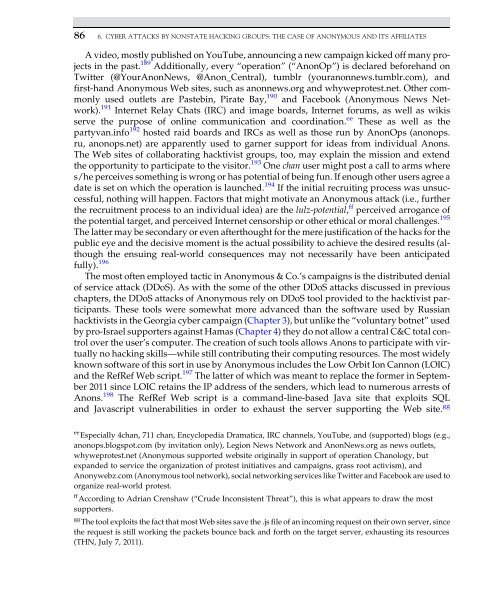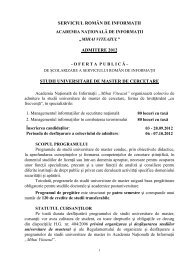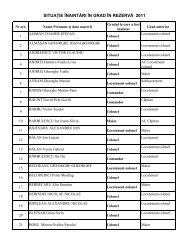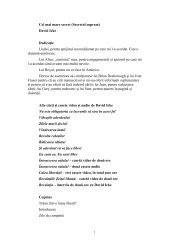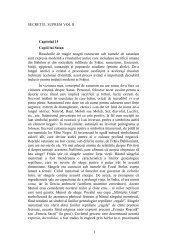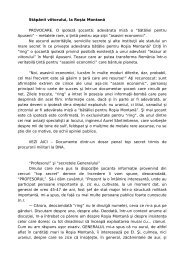Introduction to Cyber-Warfare - Proiect SEMPER FIDELIS
Introduction to Cyber-Warfare - Proiect SEMPER FIDELIS
Introduction to Cyber-Warfare - Proiect SEMPER FIDELIS
You also want an ePaper? Increase the reach of your titles
YUMPU automatically turns print PDFs into web optimized ePapers that Google loves.
86 6. CYBER ATTACKS BY NONSTATE HACKING GROUPS: THE CASE OF ANONYMOUS AND ITS AFFILIATESA video, mostly published on YouTube, announcing a new campaign kicked off many projectsin the past. 189 Additionally, every “operation” (“AnonOp”) is declared beforehand onTwitter (@YourAnonNews, @Anon_Central), tumblr (youranonnews.tumblr.com), andfirst-hand Anonymous Web sites, such as anonnews.org and whyweprotest.net. Other commonlyused outlets are Pastebin, Pirate Bay, 190 and Facebook (Anonymous News Network).191 Internet Relay Chats (IRC) and image boards, Internet forums, as well as wikisserve the purpose of online communication and coordination. ee These as well as thepartyvan.info 192 hosted raid boards and IRCs as well as those run by AnonOps (anonops.ru, anonops.net) are apparently used <strong>to</strong> garner support for ideas from individual Anons.The Web sites of collaborating hacktivist groups, <strong>to</strong>o, may explain the mission and extendthe opportunity <strong>to</strong> participate <strong>to</strong> the visi<strong>to</strong>r. 193 One chan user might post a call <strong>to</strong> arms wheres/he perceives something is wrong or has potential of being fun. If enough other users agree adate is set on which the operation is launched. 194 If the initial recruiting process was unsuccessful,nothing will happen. Fac<strong>to</strong>rs that might motivate an Anonymous attack (i.e., furtherthe recruitment process <strong>to</strong> an individual idea) are the lulz-potential, ff perceived arrogance ofthe potential target, and perceived Internet censorship or other ethical or moral challenges. 195The latter may be secondary or even afterthought for the mere justification of the hacks for thepublic eye and the decisive moment is the actual possibility <strong>to</strong> achieve the desired results (althoughthe ensuing real-world consequences may not necessarily have been anticipatedfully). 196The most often employed tactic in Anonymous & Co.’s campaigns is the distributed denialof service attack (DDoS). As with the some of the other DDoS attacks discussed in previouschapters, the DDoS attacks of Anonymous rely on DDoS <strong>to</strong>ol provided <strong>to</strong> the hacktivist participants.These <strong>to</strong>ols were somewhat more advanced than the software used by Russianhacktivists in the Georgia cyber campaign (Chapter 3), but unlike the “voluntary botnet” usedby pro-Israel supporters against Hamas (Chapter 4) they do not allow a central C&C <strong>to</strong>tal controlover the user’s computer. The creation of such <strong>to</strong>ols allows Anons <strong>to</strong> participate with virtuallyno hacking skills—while still contributing their computing resources. The most widelyknown software of this sort in use by Anonymous includes the Low Orbit Ion Cannon (LOIC)and the RefRef Web script. 197 The latter of which was meant <strong>to</strong> replace the former in September2011 since LOIC retains the IP address of the senders, which lead <strong>to</strong> numerous arrests ofAnons. 198 The RefRef Web script is a command-line-based Java site that exploits SQLand Javascript vulnerabilities in order <strong>to</strong> exhaust the server supporting the Web site. ggee Especially 4chan, 711 chan, Encyclopedia Dramatica, IRC channels, YouTube, and (supported) blogs (e.g.,anonops.blogspot.com (by invitation only), Legion News Network and AnonNews.org as news outlets,whyweprotest.net (Anonymous supported website originally in support of operation Chanology, butexpanded <strong>to</strong> service the organization of protest initiatives and campaigns, grass root activism), andAnonywebz.com (Anonymous <strong>to</strong>ol network), social networking services like Twitter and Facebook are used <strong>to</strong>organize real-world protest.ff According <strong>to</strong> Adrian Crenshaw (“Crude Inconsistent Threat”), this is what appears <strong>to</strong> draw the mostsupporters.gg The <strong>to</strong>ol exploits the fact that most Web sites save the .js file of an incoming request on their own server, sincethe request is still working the packets bounce back and forth on the target server, exhausting its resources(THN, July 7, 2011).


